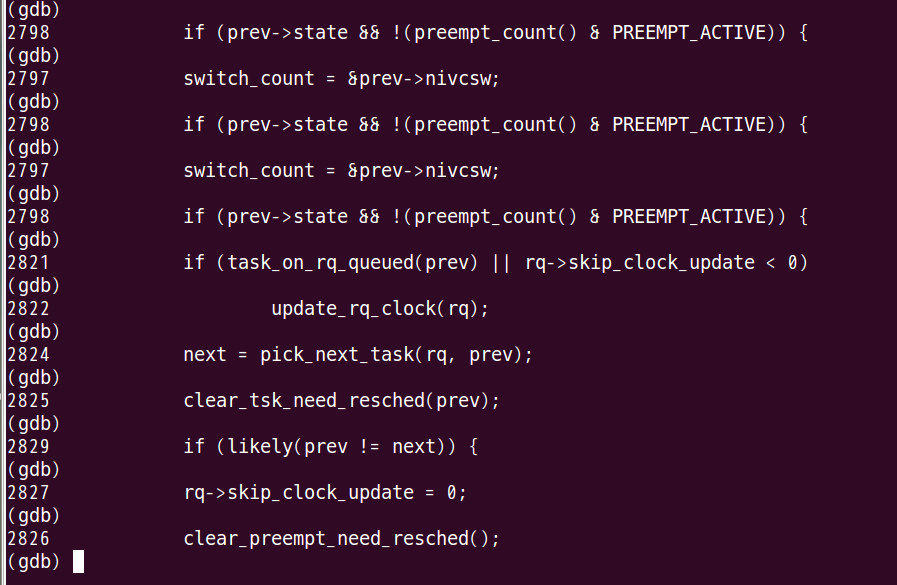Linux进程调度与切换
作品转载请注明出处 《Linux内核分析》MOOC课程http://mooc.study.163.com/course/USTC-1000029000
实验概述
进程调度和上下文切换的过程,会涉及到进度调度的时机和进程的切换执行过程,并通过GDB跟踪Linux的schedule()函数来比较深入的理解。
调度策略和时机
调度策略
操作系统中包含有很多进程调度的算法,内核会依据进程的属性来选择不同的调度策略。进程可以比较粗略的分为:IO密集型的和CPU计算密集型的,为了让计算机的资源有很高的利用率,内核会依据进程的基本属性来选择不同的调度策略。
调度类型又可分为分时调度和优先级调度,分时调度就是为每个进程分配不同的时间片,而优先级调度会从优先队列中选取优先级最高的那个进程调度。需要注意的 是,在运行的过程中,进程的优先级会发生变化的。一般来说,执行越长时间的进程,优先级会降低,而等待时间越久进程的优先级会逐渐增加。
调度时机
进程的调度通过schedule()函数实现的,它是个内核函数,不是用户态函数。所以用户态的进程不能直接调用,只能间接调用,内核线程是只有内核态没有用户态的特殊进程。进程调度发生在下面几种情况下:
1.中断处理过程(包括时钟中断、I/O中断、系统调用和异常)中,直接调用schedule(),或者返回用户态时根据need_resched标记调用schedule();
2.内核线程可以直接调用schedule()进行进程切换,也可以在中断处理过程中进行调度,也就是说内核线程作为一类的特殊的进程可以主动调度,也可以被动调度;
3.用户态进程无法实现主动调度,仅能通过陷入内核态后的某个时机点进行调度,即在中断处理过程中进行调度。
关于shedule()函数
schedule函数位于/kernel/sched/core.c文件中,其内核代码描述如下:
static void __sched __schedule(void)
{
struct task_struct *prev, *next;
unsigned long *switch_count;
struct rq *rq;
int cpu;
need_resched:
preempt_disable();
cpu = smp_processor_id();
rq = cpu_rq(cpu);
rcu_note_context_switch(cpu);
prev = rq->curr;
schedule_debug(prev);
if (sched_feat(HRTICK))
hrtick_clear(rq);
/*
* Make sure that signal_pending_state()->signal_pending() below
* can't be reordered with __set_current_state(TASK_INTERRUPTIBLE)
* done by the caller to avoid the race with signal_wake_up().
*/
smp_mb__before_spinlock();
raw_spin_lock_irq(&rq->lock);
switch_count = &prev->nivcsw;
if (prev->state && !(preempt_count() & PREEMPT_ACTIVE)) {
if (unlikely(signal_pending_state(prev->state, prev))) {
prev->state = TASK_RUNNING;
} else {
deactivate_task(rq, prev, DEQUEUE_SLEEP);
prev->on_rq = 0;
/*
* If a worker went to sleep, notify and ask workqueue
* whether it wants to wake up a task to maintain
* concurrency.
*/
if (prev->flags & PF_WQ_WORKER) {
struct task_struct *to_wakeup;
to_wakeup = wq_worker_sleeping(prev, cpu);
if (to_wakeup)
try_to_wake_up_local(to_wakeup);
}
}
switch_count = &prev->nvcsw;
}
if (task_on_rq_queued(prev) || rq->skip_clock_update < 0)
update_rq_clock(rq);
next = pick_next_task(rq, prev);
clear_tsk_need_resched(prev);
clear_preempt_need_resched();
rq->skip_clock_update = 0;
if (likely(prev != next)) {
rq->nr_switches++;
rq->curr = next;
++*switch_count;
context_switch(rq, prev, next); /* unlocks the rq */
/*
* The context switch have flipped the stack from under us
* and restored the local variables which were saved when
* this task called schedule() in the past. prev == current
* is still correct, but it can be moved to another cpu/rq.
*/
cpu = smp_processor_id();
rq = cpu_rq(cpu);
} else
raw_spin_unlock_irq(&rq->lock);
post_schedule(rq);
sched_preempt_enable_no_resched();
if (need_resched())
goto need_resched;
}
schedule()函数主要工作是通过pick_next_task选择一个新的进程来运行,并通过调用context_switch进行上下文的切换,这个宏调用switch_to来进行上下文切换。
进程上下文切换
宏定义switch_to,其描述如下:
#define switch_to(prev, next, last) \
do { \
/* \
* Context-switching clobbers all registers, so we clobber \
* them explicitly, via unused output variables. \
* (EAX and EBP is not listed because EBP is saved/restored \
* explicitly for wchan access and EAX is the return value of \
* __switch_to()) \
*/ \
unsigned long ebx, ecx, edx, esi, edi; \
\
asm volatile("pushfl\n\t" /* save flags */ \
"pushl %%ebp\n\t" /* save EBP */ \
"movl %%esp,%[prev_sp]\n\t" /* save ESP */ \
"movl %[next_sp],%%esp\n\t" /* restore ESP */ \
"movl $1f,%[prev_ip]\n\t" /* save EIP */ \
"pushl %[next_ip]\n\t" /* restore EIP */ \
__switch_canary \
"jmp __switch_to\n" /* regparm call */ \
"1:\t" \
"popl %%ebp\n\t" /* restore EBP */ \
"popfl\n" /* restore flags */ \
\
/* output parameters */ \
: [prev_sp] "=m" (prev->thread.sp), \
[prev_ip] "=m" (prev->thread.ip), \
"=a" (last), \
\
/* clobbered output registers: */ \
"=b" (ebx), "=c" (ecx), "=d" (edx), \
"=S" (esi), "=D" (edi) \
\
__switch_canary_oparam \
\
/* input parameters: */ \
: [next_sp] "m" (next->thread.sp), \
[next_ip] "m" (next->thread.ip), \
\
/* regparm parameters for __switch_to(): */ \
[prev] "a" (prev), \
[next] "d" (next) \
\
__switch_canary_iparam \
\
: /* reloaded segment registers */ \
"memory"); \
} while (0)
我们之前的MenuOS里面的Mykernel中进程的上下文切换就是根据switch_to来编写的,它保存前一个进程的esp、ebp、eip的值,并把下一个进程的esp、eip、ebp的值放到CPU相应的寄存器中,从而实现进程的切换。这段代码是用宏汇编的形式,需要有相当的汇编水平才能看懂,但要表达的目的很清晰,就是把保存上一个进程的esp、ebp、eip,并且把下一个待调度的进程的上下文置入CPU相应的寄存器中。
使用GDB跟踪schedule函数:



进程切换总述
1.正在运行的用户态进程A
2. 发生中断——savecs:eip/esp/eflags(current) to kernel stack,then load cs:eip(entry of a specificISR) and ss:esp(point to kernel stack).
- SAVE_ALL //保存现场
- 中断处理过程中或中断返回前调用了schedule(),其中的switch_to做了关键的进程上下文切换
- 标号1之后开始运行用户态进程Y(这里Y曾经通过以上步骤被切换出去过因此可以从标号1继续执行)
- restore_all //恢复现场
- iret - pop cs:eip/ss:esp/eflags from kernel stack
- 继续运行用户态进程B
总结
Linux进程的调度和切换是通过schedule函数来实现的,进程的调度和切换是需要时机的,并不是任何时刻都能发生进程的调度、切换的。一般情况下在中断或者异常发生的情况下,Linux会发生进程的切换。
内核线程可以通过调用schedule完成进程调度,而用户进程只能通过系统调用或者发生异常时,才能进入内核态来进行schedule调度的。






















 597
597

 被折叠的 条评论
为什么被折叠?
被折叠的 条评论
为什么被折叠?








